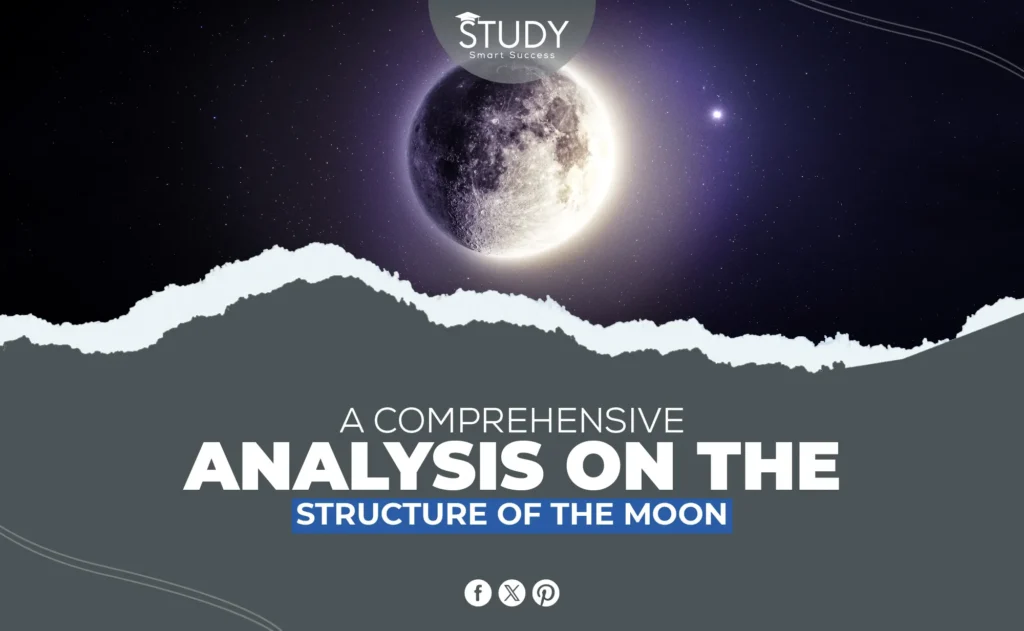Introduction
The moon, Earth’s sole natural satellite, has fascinated humans and scientists for millennia. It shines brightly in the night sky and is a key astronomical subject. Understanding the moon and its structure is important for science and practical purposes. It is the closest celestial body to the planet Earth, making studying planetary evolution and dynamics easy.
Why Study the Moon’s Structure?
Scientists use the moon’s structure to solve fundamental solar system creation and evolution issues. Researchers can learn about Earth’s formation and other solar system entities from the moon’s geology. Explore the moon’s surface and interior to prepare humanity for future space exploration by revealing the circumstances and resources future explorers may confront.
As people explore the moon, new tools and ways are made to help scientists learn more about it and send people there.
Layers of the Moon
In three main layers, scientists can learn about different parts of its old past deep below the moon’s surface.
Crust
- Thickness: varies from about 40 km in the Maria to 70 km in the Highlands. There are different shades of gray because the moon’s surface has been made by different geological processes over billions of years.
- Composition: It mostly comprises mineral-rich silicate rocks, like anorthosite and basalt. Anorthosite is common in the lunar highlands and makes the Moon look bright. On the other hand, Basalt is darker and comes from old volcanic activity in the maria.
- Regolith (Lunar Soil): A layer of shattered material covering solid bedrock from millions of years of meteorite impacts. The rocks underneath are protected from meteorite impacts and radiation by this layer. Helium-3 is used for energy generation, and water ice is used for lunar exploration and settlement.
Mantle
- Material: The mantle’s properties depend on these minerals, notably olivine and pyroxene. With its high melting point, olivine helps the mantle transmit seismic waves, whereas pyroxene increases mineral structural diversity and affects viscosity and flow.
- Properties: Its density is higher than the crust and extends 1,000 km below the surface, reflecting a long history of magmatic activity and mantle dynamics. The mantle’s density and composition hold massive thermal energy, which drives plate tectonics convection currents. This dynamic environment helps generate and recycle Earth’s materials, affects volcanic activity, and creates new crustal features.
Core
- Size: Small, with a radius of about 350 km, about the same size as some of Saturn’s and Neptune’s smaller moons in the outer solar system.
- Composition: Iron-rich, probably with sulfur and nickel, suggesting a distinct interior where heavier materials sank to form the core. This composition may contain planet-formation material.
- Magnetic Properties: A partially molten core may explain the moon’s feeble magnetic field. Its state suggests millions of years of tectonic activity and core cooling during the moon’s early thermal history and dynamo action. The ramifications of these magnetic characteristics for future exploratory missions are being studied.
Surface Features
Moon’s surface shows that it has been hit by asteroids and erupted volcanoes for a long time.
Maria (Lunar Seas)
Moonmaria, massive black basalt plains, produced 3–4 billion years ago by volcanic explosions. These eruptions formed massive lava impact basins, making the surface younger and less cratered than the highlands. Iron and magnesium-rich zones are needed to understand the moon’s volcanic history and geology. The maria covers 16% of the moon’s surface and faces Earth, unlike the highly cratered highlands.
Highlands
These brighter, more severely cratered portions constitute the moon’s earliest crust, many kilometers above the maria. The lunar highlands are dominated by lighter-colored anorthosite rocks. These locations preserve the early solar system’s bombardment era, showing how impacts formed the moon and other celestial bodies. Scientists can learn about the solar system’s ecology 4 billion years ago by studying these locations.
Craters
From little bowls to huge complexes with center peaks and terraced walls, these shapes dominate the moon. Craters are a few meters to hundreds of kilometers wide. Craters show lunar impact frequency and history. The moon’s greatest craters, including the South Pole-Aitken Basin, indicate deep crustal strata. These craters explain moon and solar system origins.
Internal Structure and Geological Activity
Geologically, the moon is not dead, as recent trips have shown. It still has a lot of changing processes going on that are important for science and exploration.
Moonquakes
Moonquakes, like earthquakes, are triggered by tidal interactions with Earth and suggest that the moon’s crust is still expanding and contracting. The moon’s solid, dry crust makes these quakes persist for up to an hour longer than earthquakes. Scientists use moonquakes to disclose strata beneath the surface that may reveal the moon’s genesis and evolution.
Seismic Data
Seismometers from the Apollo flights measured shallow and profound moonquakes. This data helps scientists map its core, mantle, and crust, revealing its tectonic activity and thermal history. The data has transformed our knowledge of the moon’s geology and billion-year development.
Moon’s Orbit and Rotation
The moon rotates synchronously with Earth, so one side always faces us. Earth’s gravity slows the moon’s spin to match its orbital cycle. The moon’s elliptical orbit changes Earth’s distance, affecting tides and sky appearance. Dynamic stress fractures, volcanic activity, and moon structural degradation occur throughout time. These methods let scientists study lunar evolution.
Scientific Missions and Discoveries
The moon has been the focus of many scientific projects that have helped us learn more about space.
Apollo Missions
These missions provided comprehensive lunar rock and surface data, improving our understanding of lunar geology. Scientific studies of moon samples’ composition, age, and history have illuminated the early solar system and planet formation thanks to the Apollo missions.
Lunar Reconnaissance Orbiter (LRO)
The LRO orbits the moon and produces accurate surface mapping for mission planning and scientific investigation. Scientific instruments like cameras and spectrometers capture high-resolution images and data. This information helps find landing locations for future manned missions, explore lunar resources, and comprehend space weathering on the moon.
Conclusion
The moon is more than a neighbor—it sheds light on our past and opens up the universe. The moon’s structure reveals its past and opens the door to future expeditions to Mars and beyond. Continuous study spurs technical innovation and human exploration.


